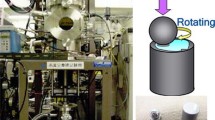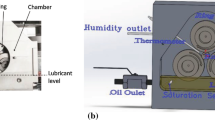Abstract
The effect of water vapor on n-pentanol vapor phase lubrication (VPL) was studied with a microelectromechanical system (MEMS) side-wall tribometer, a pin-on-disc tribometer, and attenuated total reflection infrared (ATR-IR) spectroscopy. The n-pentanol vapor pressure was fixed at 50 % relative to its saturation vapor pressure (P sat = ~2.2 Torr at room temperature), which is sufficient to maintain a monolayer of n-pentanol on a SiO2 surface in a dry Ar environment. As the relative humidity (RH) was increased from zero to 30 %, ATR-IR measurements showed that the water adsorption on the surface increases and the adsorbed pentanol thickness decreases by 60 %. These changes in the adsorption isotherm were manifested as higher, and more scattered friction coefficients observed during the MEMS tribometer operation. The maximum RH tolerance appeared to be 25–30 % RH above which the MEMS tribometer failed to operate reliably. In contrast, the n-pentanol VPL efficiency was not affected significantly during the macro-scale pin-on-disc tribometer tests. These results imply that the friction behavior of the asperity contacts in MEMS is more susceptible to co-adsorption of water than the friction behavior of macro-scale contacts.






Similar content being viewed by others
References
Komvopoulos, K.: Surface engineering and microtribology for microelectromechanical systems. Wear 200, 305–327 (1996)
Romig, A.D., Dugger, M.T., McWhorter, P.J.: Materials issues in microelectromechanical devices: science, engineering, manufacturability, reliability. Acta Mater. 51, 5837–5866 (2003)
Maboudian, R., Carraro, C.: Surface chemistry and tribology of MEMS. Annu. Rev. Phys. Chem. 55, 35–54 (2004)
Asay, D.B., Dugger, M.T., Kim, S.H.: In-situ vapor phase lubrication of MEMS. Tribol. Lett. 29, 67–74 (2008)
Asay, D.B., Dugger, M.T., Ohlhausen, J.A., Kim, S.H.: Macro- to nanoscale wear prevention via molecular adsorption. Langmuir 24, 155–159 (2008)
Barnette, A.L., Kim, S.H.: Attenuated total reflectance infrared spectroscopy study of hysteresis of water and n-alcohol coadsorption on silicon oxide. Langmuir 28, 15529–15536 (2012)
Barnette, A.L., Kim, S.H.: Coadsorption of n-propanol and water on SiO2: study of thickness, composition, and structure of binary adsorbate layer using attenuated total reflection infrared (ATR-IR) and sum frequency generation (SFG) vibration spectroscopy. J. Phys. Chem. C 116, 9909–9916 (2012)
Nashby R., Sniegowski J., Smith J., Montague S., Barron C., Eaton W., et al.: Application of chemical–mechanical polishing to planarization of surface micromachined devices. Tech. Digest. Solid state sensors and actuators workshop, vol. 3–6, pp. 48–53 (1996)
Asay, D.B., Kim, S.H.: Evolution of the adsorbed water layer structure on silicon oxide at room temperature. J. Phys. Chem. B 109, 16760–16763 (2005)
Strawhecker, K., Asay, D.B., McKinney, J., Kim, S.H.: Reduction of adhesion and friction of silicon oxide surface in the presence of n-propanol vapor in the gas phase. Tribol. Lett. 19, 17–21 (2005)
Timpe, S.J., Hook, D.A., Dugger, M.T., Komvopoulos, K.: Levitation compensation methods for dynamic electrostatic comb drive actuators. Sens. Actuators 143, 383–389 (2008)
Asay, D.B., Kim, S.H.: Molar volume and adsorption isotherm dependence of capillary forces in nanoasperity contacts. Langmuir 23, 12174–12178 (2007)
Barnette, A.L., Asay, D.B., Janik, M.J., Kim, S.H.: Adsorption isotherm and orientation of alcohols on hydrophilic SiO2 under ambient conditions. J. Phys. Chem. C 113, 10632–10641 (2009)
Dickerell, D.J., Dugger, M.T., Hamilton, M.A., Sawyer, W.G.: Direct contact-area computation for MEMS using real topographic surface data. J. MEMS Syst. 10, 1263–1268 (2007)
Tay, C.J., Quan, C., Gopal, M., Shen, L., Akkipeddi, R.: Nanoindentation techniques in the measurement of mechanical properties of InP-based free-standing MEMS structures. J. Micromech. Microeng. 18, 0205151–0205159 (2008)
Schmale D.T., Bourcier R.J.: SAND87-0742. Sandia National Laboratories (1987)
Barnette, A.L., Asay, D.B., Kim, S.H.: Average molecular orientation in the adsorbed water layers on silicon oxide in ambient conditions. Phys. Chem. Chem. Phys. 10, 4981–4986 (2008)
Barnette, A.L., Asay, D.B., Kim, D., Guyer, B.D., Lim, H., Janik, M.J., et al.: Experimental and density function theory study of the tribochemical wear behavior of SiO2 In humid and alcohol vapor environments. Langmuir 25, 13052–13061 (2009)
Hook, D.A., Timpe, S.J., Dugger, M.T., Krim, J.: Tribological degradation of fluorocarbon coated silicon microdevice surfaces in normal and sliding contact. J. Appl. Phys. 104, 0343031–03430316 (2008)
Marino, M.J., Hsiao, E., Chen, Y., Eryilmaz, O.L., Erdemir, A., Kim, S.H.: Understanding run-in behavior of diamond-like carbon friction and preventing diamond-like carbon wear in humid air. Langmuir 27, 12702–12708 (2011)
Al-Azizi, A.A., Eryilmaz, O., Erdemir, A., Kim, S.H.: Effects of nanoscale surface texture and lubricant molecular structure on boundary lubrication in liquid. Langmuir 29, 13419–13426 (2013)
Buch, V., Bauerrecker, S., Devlin, J.P., Buck, U., Kazimirski, J.K.: Solid water clusters in the size range of tens-thousands of H2O: a combined computational/spectroscopic outlook. Int. Rev. Phys. Chem. 23, 375–433 (2004)
Barthel, A.J., Al-Azizi, A., Surdyka, N.D., Kim, S.H.: Effects of gas or vapor adsorption on adhesion, friction, and wear of solid interfaces. Langmuir (2013). doi:10.1021/la402856j
Timpe, S.J., Alsem, D.H., Hook, D.A., Dugger, M.T., Komvopoulos, K.: Wear of polysilicon surface micromachines operated in high vacuum. J. MEMS Syst. 18, 229–238 (2009)
Timpe, S.J., Komvopoulos, K.: An experimental study of sidewall adhesion in MEMS. J. MEMS Syst. 14, 1356–1363 (2005)
Asay, D.B., de Boer, M.P., Kim, S.H.: Equilibrium vapor adsorption and capillary force: exact laplace-young equation solution and circular approximation approaches. J. Adhes. Sci. Technol. 24, 2363–2382 (2010)
Hsiao, E., Marino, M.J., Kim, S.H.: Effects of gas adsorption isotherm and liquid contact angle on capillary force for sphere-on-flat and cone-on-flat geometries. J. Coll. Interface Sci. 352, 549–557 (2010)
Wei, Z., Zhao, Y.P.: Growth of liquid bridge in AFM. J. Phys. D Appl. Phys. 40, 4368–4375 (2007)
Asay, D.B., Hsiao, E., Kim, S.H.: Effects of adsorbate coverage and capillary on nano-asperity friction in atmosphere containing organic vapor. J. Appl. Phys. 110, 064326 (2011)
Wu, D., Fang, N., Sun, C., Zhang, X.: Adhesion force of polymeric three-dimensional microstructures fabricated by microstereolithography. Appl. Phys. Lett. 18, 3963–3965 (2002)
Acknowledgments
This work was financially supported by the National Science Foundation (Grant No. CMMI-1000021) and Sandia National Laboratories. Sandia is a multiprogram laboratory operated by Sandia Corporation, a Lockheed Martin Company, for the United States Department of Energy’s National Nuclear Security Administration under contract DE-AC04-94AL85000.
Author information
Authors and Affiliations
Corresponding authors
Electronic supplementary material
Below is the link to the electronic supplementary material.
Rights and permissions
About this article
Cite this article
Barnette, A.L., Ohlhausen, J.A., Dugger, M.T. et al. Humidity Effects on In Situ Vapor Phase Lubrication with n-Pentanol. Tribol Lett 55, 177–186 (2014). https://doi.org/10.1007/s11249-014-0345-9
Received:
Accepted:
Published:
Issue Date:
DOI: https://doi.org/10.1007/s11249-014-0345-9




